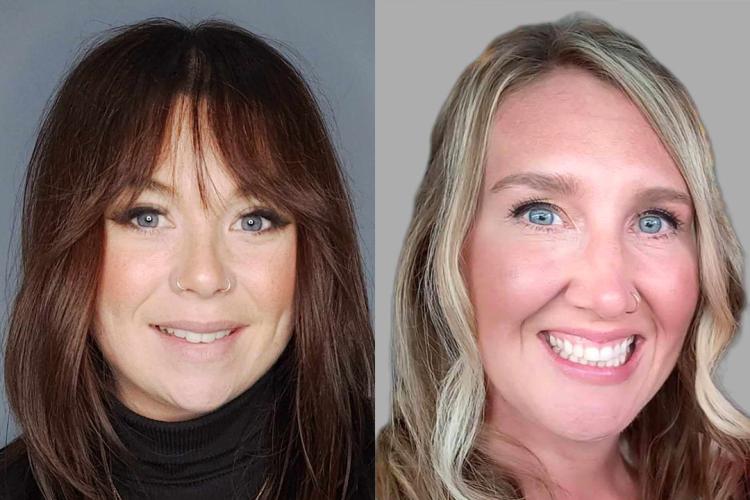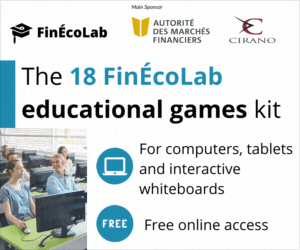By Connor Jay
Kristin Moskalyk and Nicole Lamoureux, graduate students from the University of Saskatchewan's (USask) Educational Technology and Design (ETAD) program through the College of Education, were awarded $10,000 as finalists in the Metaverse for Sustainable Development Goals Global Prize and Virtual Reality Competition.

From left: Kristin Moskalyk and Nicole Lamoureux are graduate students from the Educational Technology and Design (ETAD) program. (Photos: Submitted)
Selected from 257 teams in more than 70 countries, the students' research in immersive learning and sustainability education resulted in a virtual reality world designed for learning about marine conservation and sustainable ocean resources.
Moskalyk is a former elementary school teacher and Lamoureux teaches secondary students in Alberta. Both are instructional designers at the Gwenna Moss Centre for Teaching and Learning at USask. The goal of their project was to create a metaverse that would "develop knowledge, empathy and support for SDG 14, for users that are landlocked."
"Being recognized by peers and experts in the field is a tremendous honour," Moskalyk said. "It validates our dedication to creating innovative and impactful educational experiences for students."
Moskalyk and Lamoureux intertwined their passion for teaching, personal teaching philosophies, understanding of instructional design and pedagogy and love of water sports and activities to create a metaverse designed to engage and educate students on marine conservation and sustainable ocean resources. The metaverse was developed as an ambitious final project in the course Sustainability Teaching & Learning through Design and Technology, offered by assistant professor of Curriculum Studies Dr. Paula MacDowell (PhD).
Titled Techy Teachers - Diving into life below water, Moskalyk and Lamoureux designed a virtual reality world that aligns with the United Nations' Sustainable Development Goal (SDG) 14: Life Below Water. The goal of SDG 14 is to "conserve and sustainably use the oceans, seas and marine resources for sustainable development." They named their metaverse SDG Island and included comprehensive learning materials for students to engage with.
Students are introduced to SDG Island with introductory information and tasks. (Photo: Screenshot via framevr.io)
"Because we have both been teachers, having a solid foundation of understanding the Saskatchewan and Alberta curriculums allowed us to easily develop pedagogy-focused [learning materials] that kids would engage with," said Lamoureux. "All of the design elements we utilized [in the metaverse] were to grab the student's attention, but not overwhelm them."
"We were initially designing the metaverse for our students [from Alberta and Saskatchewan] who are landlocked and aren't exposed to what's happening out in our oceans and coastlines every day," added Moskalyk. "[Using gamification] we crafted tasks and provided a storyline that would guide students through the experience and helps to lighten the load on a serious and complex issue."
Users are welcomed to SDG Island with a news broadcast video that introduces tasks to accomplish. In the metaverse, there are opportunities to view information via videos and slides, participate in discussions and activities, create and design ways to contribute to SDG 14 and guidelines to connect the concepts from the metaverse to the real world. The accessible layout allows users to explore the metaverse via a VR headset, desktop computer, tablet or mobile device.
MacDowell emphasized the synergies between innovative technology, teaching and learning as to why the project garnered attention from the Sustainable Development Goals (SDG) Metaverse Global Prize & Virtual Reality (VR) Competition committee and is excited that Moskalyk and Lamoureux earned a Level 2 - Solid Contenders finalist prize in the competition.
"I had the good fortune of being the professor to mentor, guide and learn from Kristin and Nicole's project," said MacDowell. "What stands out about the metaverse they designed is the meaningful integration of pedagogy and technology for deep and meaningful learning. Their project stood out because the use of the virtual learning environment for authentic and comprehensive learning of a topic that is hard to teach, but they did it in an engaging way."
Moskalyk and Lamoureux were candid about not being VR designers and noted the technological disadvantage they were at compared to other finalists. The duo relied on their understanding of pedagogy and curriculum and the deep thought that went into the content in the metaverse that promoted education, empathy, and awareness towards the SDGs to separate themselves from the competition.
"The competition judges were super keen on our project because it also came with a learning journal," said Lamoureux. "The learning journal scaffolds the learning experience and promotes reflection on the content. We used student-friendly language to enhance user engagement and designed the platform with accessibility in mind."
Although Moskalyk and Lamoureux were tasked with educating others about SDG 14, they also went on their own learning journey. A common theme was gaining awareness of all 17 SDGs.
"I was introduced to the SDGs as a whole for the first time," said Moskalyk. "Learning about [each SDGs] targets and indicators and which goals are moving forward, and which ones aren't, was really eye opening for me."
"The most important thing that I took away from all of this is the actual interconnectedness of all of the SDGs playing a part on each one," added Lamoureux. "I wasn't aware of the Sustainable Development Goals when beginning our research. It wasn't something that was taught in my school and unless you were aware of the goals, accessing information can be challenging. Once you know about the SDGs you can begin your own research and become a more informed global citizen."
As climate change issues rise, environmental sustainability becomes more critical. Lamoureux notes how individuals can take steps to reduce their carbon footprint and highlights the interconnectedness of other SDGs to climate change.
"Activities like carpooling or taking your bike to work help reduce the amount of carbon emissions. Those carbon emissions create ocean acidification in the water, which poses threats such as coral bleaching and other negative impacts within our water systems."
From a policy level, Moskalyk wants to see more support for innovation within the SDGs.
"There are lots of people out there that have innovative ideas on ways to protect our watersheds. I think that there's a lot of room to grow using AI and marine biotechnology."
Regarding sustainability education, Moskalyk and Lamoureux have set a precedent for what can be accomplished through the ETAD degree. MacDowell is looking forward to empowering future students with the innovative opportunities available in the course.
"I'm teaching the same sustainability course this upcoming spring that Kristin and Nicole took," shared MacDowell. "What an inspiration these two are for the students. They've shown what can be achieved with the course projects. They are global changemakers with the impactful work they've accomplished. [This project will] show motivate other students to see what is possible."











